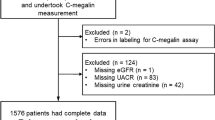Abstract
Background
Injury to renal tubules plays an important role in the development of various renal diseases; however, the prevalence and significance of renal tubular damage in the general population are unclear. To clarify this point, we conducted a community-based study, using urinary β2-microglobulin as a marker of tubular damage.
Methods
The subjects studied were 3,444 Japanese over the age of 40 years. The urinary β2-microglobulin–creatinine ratio (UBCR) was assessed in morning spot urine samples.
Results
In this population, the distribution of the UBCR among these subjects was skewed towards higher values and a high UBCR (≥300 μg/g) was identified in 438 (12.7%) subjects. However, overlap with macroalbuminuria and renal insufficiency [estimated glomerular filtration rate (eGFR) <60 mL/min/1.73 m2] was observed in only 25 (5.7%) and 58 (13.2%) of these subjects, respectively. Multivariate analysis indicated that a high UBCR was positively associated with aging, hypertension, macroalbuminuria and increased urinary sodium excretion. A 5-year longitudinal analysis in 899 subjects indicated a greater decline in eGFR in parallel with the increase in baseline UBCR. After adjustment for possible confounders, a high UBCR was an independent risk factor for rapid decline in eGFR [<−10 mL/min/1.73 m2; odds ratio 1.79 (95% confidence interval 1.07–2.99), P = 0.026].
Conclusion
This study showed that renal tubular damage was common and was an independent risk factor for renal deterioration in the Japanese population. More attention should be paid to occult renal tubular damage in order to prevent end-stage renal disease.




Similar content being viewed by others
References
Lambers Heerspink HJ, Brinkman JW, Bakker SJ, Gansevoort RT, de Zeeuw D. Update on microalbuminuria as a biomarker in renal and cardiovascular disease. Curr Opin Nephrol Hypertens. 2006;15:631–6.
Ikeda A, Konta T, Takasaki S, Hao Z, Suzuki K, Sato H, et al. In a non-diabetic Japanese population, the combination of macroalbuminuria and increased urine beta 2-microglobulin predicts a decline of renal function: the Takahata study. Nephrol Dial Transplant. 2009;24:841–7.
Nishijo M, Morikawa Y, Nakagawa H, Tawara K, Miura K, Kido T, et al. Causes of death and renal tubular dysfunction in residents exposed to cadmium in the environment. Occup Environ Med. 2006;63:545–50.
Nishijo M, Nakagawa H, Morikawa Y, Kuriwaki J, Katsuyuki M, Kido T, et al. Mortality in a cadmium polluted area in Japan. Biometals. 2004;17:535–8.
Hrabar A, Aleraj B, Ceović S, Cvoriscec D, Vacca C, Hall PW 3rd. A fifteen year cohort based evaluation of beta 2-microglobulin as an early sign of Balkan endemic nephropathy. Kidney Int Suppl. 1991;34:S41–3.
Konta T, Hao Z, Abiko H, Ishikawa M, Takahashi T, Ikeda A, et al. Prevalence and risk factor analysis of microalbuminuria in Japanese general population: the Takahata study. Kidney Int. 2006;70:751–6.
Japanese Society of Nephrology. Evidence-based practice guideline for the treatment of CKD. Clin Exp Nephrol. 2009;13:537–66.
Matsuo S, Imai E, Horio M, Yasuda Y, Tomita K, Nitta K, et al. Collaborators developing the Japanese equation for estimated GFR: revised equations for estimated GFR from serum creatinine in Japan. Am J Kidney Dis. 2009;53:982–92.
Kawasaki T, Itoh K, Uezono K, Sasaki H. A simple method for estimating 24 h urinary sodium and potassium excretion from second morning voiding urine specimen in adults. Clin Exp Pharmacol Physiol. 1993;20:7–14.
Rifkin DE, Shlipak MG, Katz R, Fried LF, Siscovick D, Chonchol M, et al. Rapid kidney function decline and mortality risk in older adults. Arch Intern Med. 2008;168:2212–8.
Imai E, Horio M, Yamagata K, Iseki K, Hara S, Ura N, et al. Slower decline of glomerular filtration rate in the Japanese general population: a longitudinal 10-year follow-up study. Hypertens Res. 2008;31:433–41.
Karlsson FA, Lenkei R. Urinary excretion of albumin and beta 2-microglobulin in a population from an area where Balkan nephropathy is endemic. Scand J Clin Lab Invest. 1977;37:169–73.
Hwang KK, Scott LJ, Chifamba J, Mufunda J, Spielman WS, Sparks HV. Microalbuminuria in urban Zimbabwean women. J Hum Hypertens. 2000;14:587–93.
Moriguchi J, Ezaki T, Tsukahara T, Fukui Y, Ukai H, Okamoto S, et al. Effects of aging on cadmium and tubular dysfunction markers in urine from adult women in non-polluted areas. Int Arch Occup Environ Health. 2005;78:446–51.
Luft FC. Microalbuminuria and essential hypertension: renal and cardiovascular implications. Curr Opin Nephrol Hypertens. 1997;6:553–7.
Guder WG, Hofmann W. Clinical role of urinary low molecular weight proteins: their diagnostic and prognostic implications. Scand J Clin Lab Invest Suppl. 2008;241:95–8.
Nickolas TL, Barasch J, Devarajan P. Biomarkers in acute and chronic kidney disease. Curr Opin Nephrol Hypertens. 2008;17:127–32.
Hellström L, Elinder CG, Dahlberg B, Lundberg M, Järup L, Persson B, et al. Cadmium exposure and end-stage renal disease. Am J Kidney Dis. 2001;38:1001–8.
Acknowledgments
A grant-in-aid from the 21st Century Center of Excellence (COE) and Global COE program of the Japan Society for the Promotion of Science.
Conflict of interest
The authors have declared that no conflict of interest exists.
Author information
Authors and Affiliations
Corresponding author
About this article
Cite this article
Kudo, K., Konta, T., Mashima, Y. et al. The association between renal tubular damage and rapid renal deterioration in the Japanese population: the Takahata study. Clin Exp Nephrol 15, 235–241 (2011). https://doi.org/10.1007/s10157-010-0392-y
Received:
Accepted:
Published:
Issue Date:
DOI: https://doi.org/10.1007/s10157-010-0392-y




